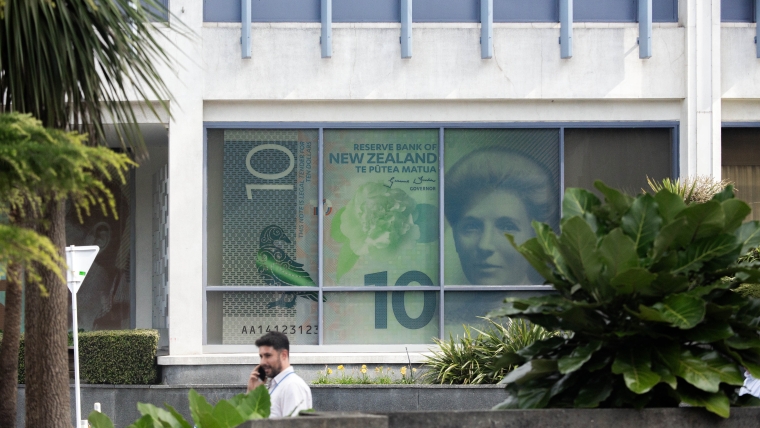
Economists at BNZ say the Reserve Bank should cut interest rates at least twice this year after the June labour market data was “unequivocally weak”.
While the headline unemployment rate rose only 0.1 points to 5.2%, other important measures showed growing slack in New Zealand’s job market.
“A look under the bonnet reveals a picture that is at least as soft as we had feared, and one which is certainly weaker than the Reserve Bank had expected when it put together its May Monetary Policy Statement,” Doug Steel and Stephen Toplis said.
Employment has only increased once in the past six quarters and was down 0.9% from a year ago and 1.2% from its peak in early 2023. That’s a loss of 36,000 jobs.
Workers also have less to do. Hours worked dropped 1% in June and a total of 4% over the past six quarters, to the same level as June 2022.
“Importantly, the decline in hours worked in the quarter will be reflected in the Q2 GDP outturn. We are currently forecasting a 0.2% decline for the quarter. There is nothing in today’s data to suggest there is any upside to this prediction,” the economists said.
A labour force participation rate in “freefall” was the only reason the unemployment rate was at 5.2%, and still appeared to be in line with the RBNZ’s forecast.
“This drop in participation is people who have either given up looking for a job, because it’s all too hard, or who have gone back to get further education.”
Unemployment would be “substantially higher” if these people had remained in the workforce, as the central bank had assumed they would, Steel and Toplis said.
“From the central bank’s perspective, the labour market depicts an economy crying out for more support … We thus maintain our view that rates should be cut in both August and October.”
Analysis by ANZ, prior to the data release, showed financial markets expected the RBNZ to cut the Official Cash Rate twice by February 2026 — likely at the August and November meetings.
Paul Conway, the Reserve Bank’s chief economist, said in a recent speech the Monetary Policy Committee expected to lower rates further if inflation pressures continued to ease.
‘Glass Half Empty economics’
Finance Minister Nicola Willis said the unemployment figures were lower than forecast by the Treasury both at the budget and prior to the election.
“That is not to say we are satisfied with this rate of unemployment. We are concerned for every New Zealander that wants a job and can’t get one,” she said.
The lower rate meant 8,000 fewer people were ‘unemployed’ than the Treasury expected, although these people may not have jobs. Many are in education or simply staying home.
Willis acknowledged more young people were entering training and education, rather than taking jobs, but didn’t think that was necessarily a bad thing.
“Some [commentators] have got into the habit of what I call Glass Half Empty Economics. Today, on the plain facts of the data, is a lower unemployment rate than was forecast by the Treasury and commercial banks,” she told reporters.
“For once, let's not look the horse in the mouth and see this for what it is, which is a lower rate of unemployment than we were expecting.”
Those who had the “incredibly tough” experience of losing their jobs shouldn’t take it personally, as it was the result of high inflation and interest rates.
She said the Government would continue to pull whatever levers it could to create jobs.
“We are pumping cash into this economy. We have a $10 billion deficit this year which we are forecasting will increase next year. That’s because we believe it is not the right time to stop spending on health, education and police,” she said.
24 Comments
Who could have foreseen more OCR cuts, I wonder ?
I find it all so boring Dr Y. You know they want it. You know you want it.
I'm more interested in Trumpistan. Heightened volatility in US Treasury markets may force the Fed to cut interest rates sooner than many anticipate. Pay attention to the MOVE Index (a measure of bond market volatility). If it climbs above a certain threshold (140), market participants might be forced to sell treasuries and corporate bonds, potentially prompting rapid rate cuts by the Fed to calm financial stress.
Political risk, such as new trade tariffs, can amplify volatility and push the Fed toward dovish actions. Recent US govt policies as likely to lead to credit expansion through mechanisms that bypass traditional monetary policy (for example, via govt-backed loans), which could in turn increase the money supply and lower rates in practice.
The US Treasury - not just the Fed - has been the prime driver of global liquidity since 2024. Treasury actions, such as new bill issuance and the injection of hundreds of billions of dollars in new liquidity, directly impact financial markets. This liquidity has lifted prices in risk assets including stocks, the ol' rat poison and crypto - even while the Fed maintained QT. Despite perceived liquidity injections, credit growth from major economies remains insufficient for strong nominal GDP growth, so any liquidity-driven rallies could be short-lived, and possibly followed by corrections.
And persistent inflation, currency volatility, and geopolitical instability (including trade tensions and global political risks) means assets like gold and gold mining equities have been the place to be in 2025. Miners are reporting record revenues, operating cash flows, and profit margins - substantially stronger yoy compared to 2024.
You're mistaken, I don't particularly want lower rates. It's just that I understand what poor health the NZ economy is in.
You're mistaken, I don't particularly want lower rates. It's just that I understand what poor health the NZ economy is in.
So what does that mean? That the health of the Aotearoa economy depends on the Ponzi running on all cylinders?
Sounds like the general consensus among the BBQ set is that a lower price of debt is the only way forward.
Who could have foreseen more OCR cuts, I wonder ?
Trump has, will even fire the FED Chairman to get them.... You and trump are like brothers
Trump is not forseeing lower rates. He wants them for his selfish reasons. Personally, I don't care if rates go up or down. It's just that I understand the poor shape the NZ economy is in, which will inexorably lead to lower rates.
We are pumping cash into the economy - with an increasing focus on making sure that cash gets to people with a low propensity to spend. We are sure that this is the right thing to do.
It's not even the propensity to spend, it's that the increasing desire for luxury by the decent number of elite drives up the cost of goods for everyone.
I don't know how many people are totally sure it's the right thing to do, but it's innate to the system we are running and has been observed for centuries.
Very rare for things to fundamentally improve without them getting way worse first.
Keep pumping Willis....
no no that came out the wrong way.
Oh so the government are spending now? I thought it was all about tightening the belt. Their economic policy of hoping and praying households will suddenly start splurging isn't going according to plan I guess.
Nothing sharpens the mind, like a good hanging in the Polls.
The banks want lower interest rates...quelle surprise
Knock me over wi-
And if inflation keeps creeping up?
we will look through it
RBNZ should have made a shock 0.75% cut last review instead of a hold. Domestic inflation isn’t going anywhere while no one is spending.
Imagine if they had to consider full employment instead of only panicking about inflation being a small amount over 2%.
Yep. I'm still baffled as to why they're pausing. It's pretty obvious what they've done so far isn't cutting it. My daughter works in hospo and is almost certain to lose her job as the owners contemplate closing the doors. There cafes and restaurants around town that have either folded or are on the brink. If that's not a good anecdote, I don't know what is.
Yep. I'm still baffled as to why they're pausing
- lessons learned from previous experience fighting inflation
- if lowered too much now, there's less capacity to use the OCR to rescue the economy
Part of the reason hospo is getting a bashing is costs are too high, and can't be passed on. Because it's a nice to have.
Very simple, they see govt starting to finally commit spending into the economy and want to allow time to see the delayed impact of previous decreases. Coupled with medium term risk of inflation caused by increased in said government spending and a possible uptick in the private sector jobs resultingly. Why use your only lever to cheapen debt if there is the potential of inflation caused by government decisions, lest they end up with the lever bein useless if rates are too low and inflation picks up faster than expected. Orr already left with egg on his face. I suspect the new Governor wishes to avoid such an image.
So when inflation is where they want it (now) but we need shock cuts? But when inflation was double the mandated level (a few years ago) or more the idea is to 'look through it' and keep pausing with OCR at emergency 0% levels? Where is the consistency? It is no way to manage an economy. It is not balanced or prudent thinking.
You do emergency things when they have inflation where they want it - but you don't nothing when it is absolutely not where it is meant to be? It like a comedy show gone wrong.
If the banks are offering TDs at ~4% for six months, nine months 1 year, 18months and two years, does that mean there'll be two or more OCR cuts within the next six months?
It might be good if the cash being pumped in to the economy was aimed at our productive capacity, rather than letting blunt instrument OCR cuts kick off the national obsession with property while fuelling overseas banks' profit margins, yet again.
It's ruining us as a productive nation.

We welcome your comments below. If you are not already registered, please register to comment
Remember we welcome robust, respectful and insightful debate. We don't welcome abusive or defamatory comments and will de-register those repeatedly making such comments. Our current comment policy is here.